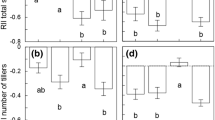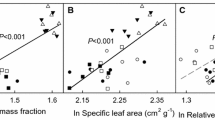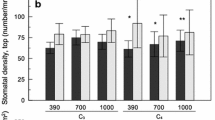Abstract
We hypothesized that the greater competitive ability of invasive exotic plants relative to native plants would increase under elevated CO2 because they typically have traits that confer the ability for fast growth when resources are not limiting and thus are likely to be more responsive to elevated CO2. A series of competition experiments under ambient and elevated CO2 glasshouse conditions were conducted to determine an index of relative competition intensity for 14 native-invasive exotic species-pairs. Traits including specific leaf area, leaf mass ratio, leaf area ratio, relative growth rate, net assimilation rate and root weight ratio were measured. Competitive rankings within species-pairs were not affected by CO2 concentration: invasive exotic species were more competitive in 9 of the 14 species-pairs and native species were more competitive in the remaining 5 species-pairs, regardless of CO2 concentration. However, there was a significant interaction between plant type and CO2 treatment due to reduced competitive response of native species under elevated compared with ambient CO2 conditions. Native species had significantly lower specific leaf area and leaf area ratio under elevated compared with ambient CO2. We also compared traits of more-competitive with less-competitive species, regardless of plant type, under both CO2 treatments. More-competitive species had smaller leaf weight ratio and leaf area ratio, and larger relative growth rate and net assimilation rate under both ambient and elevated CO2 conditions. These results suggest that growth and allocation traits can be useful predictors of the outcome of competitive interactions under both ambient and elevated CO2 conditions. Under predicted future atmospheric CO2 conditions, competitive rankings among species may not change substantially, but the relative success of invasive exotic species may be increased. Thus, under future atmospheric CO2 conditions, the ecological and economic impact of some invasive exotic plants may be even greater than under current conditions.

Similar content being viewed by others
References
Bando K (2006) The roles of competition and disturbance in a marine invasion. Biol Invasions 8:755–763
Barney J, Whitlow T, DiTommaso A (2009) Evolution of an invasive phenotype: shift to belowground dominance and enhanced competitive ability in the introduced range. Plant Ecol 202:275–284
Baruch Z, Jackson RB (2005) Responses of tropical native and invader C4 grasses to water stress, clipping and increased atmospheric CO2 concentration. Oecologia 145:522–532
Beck KG et al (2009) Invasive species defined in a policy context: recommendations from the Federal Invasive Species Advisory Committee. Invasive Plant Sci Manage 1:414–421
Belote RT, Weltzin JF, Norby RJ (2003) Response of an understory plant community to elevated [CO2] depends on differential responses of dominant invasive species and is mediated by soil water availability. New Phytol 161:827–835
Bradford MA, Schumacher HB, Catovsky S, Eggers T, Newingtion JE, Tordoff GM (2007) Impacts of invasive plant species on riparian plant assemblages: interactions with elevated atmospheric carbon dioxide and nitrogen deposition. Oecologia 152:791–803
Burns JH (2006) Relatedness and environment affect traits associated with invasive and non-invasive introduced Commelinaceae. Ecol Appl 16:1367–1376
Callaway RM, Aschehoug ET (2000) Invasive plants versus their new and old neighbors: a mechanism for exotic invasion. Science 290:521–523
Coleman H, Levine J (2007) Mechanisms underlying the impacts of exotic annual grasses in a coastal California meadow. Biol Invasions 9:65–71
Corbin JD, D’Antonio CM (2004) Competition between native perennial and exotic annual grasses: implications for an historical invasion. Ecology 85:1273–1283
Dassonville N, Vanderhoeven S, Vanparys V, Hayez M, Gruber W, Meerts P (2008) Impacts of alien invasive plants on soil nutrients are correlated with initial site conditions in NW Europe. Oecologia 157:131–140
Dukes JS (2000) Will increasing atmospheric CO2 concentration affect the success of invasive species. Island Press, Washington DC
Dukes JS (2002) Comparison of the effect of elevated CO2 on an invasive species (Centaurea solstitialis) in monoculture and community settings. Plant Ecol 160:225–234
Dukes JS, Mooney HA (1999) Does global change increase the success of biological invaders? Trends Ecol Evol 14:135–139
Eriksson O (1997) Colonization dynamics and relative abundance of three plant species (Antennaria dioica, Hieradum pilosella and Hypochoeris maculata) in dry semi-natural grasslands. Ecography 20:559–568
Ewing K (2002) Effects of initial site treatments on early growth and three-year survival of Idaho Fescue. Restor Ecol 10:282–288
Goldberg DE, Rajaniemi T, Gurevitch J, Stewart-Oaten A (1999) Empirical approaches to quantifying interaction intensity: competition and facilitation along productivity gradients. Ecology 80:1118–1131
Grace JB (1995) On the measurement of plant competition intensity. Ecology 76:305–308
Grotkopp E, Rejmanek M (2007) High seedling relative growth rate and specific leaf area are traits of invasive species: phylogenetically independent contrasts of woody angiosperms. Am J Bot 94:526–532
Grotkopp E, Rejmanek M, Rost TL (2002) Toward a causal explanation of plant invasiveness: seedling growth and life-history strategies of 29 pine (Pinus) species. Am Nat 159:396
Groves RH, Austin MP, Kaye PE (2003) Competition between Australian native and introduced grasses along a nutrient gradient. Austral Ecol 28:491–498
Hager H (2004) Competitive effect versus competitive response of invasive and native wetland plant species. Oecologia 139:140–149
Hamilton JG, Holzapfel C, Mahall BE (1999) Coexistence and interference between a native perennial grass and non-native annual grasses in California. Oecologia 121:518–526
Hattenschwiler S, Korner C (2003) Does elevated CO2 facilitate naturalization of the non-indigenous Prunus laurocerasus in Swiss temperate forests? Funct Ecol 17:778–785
Hellmann JJ, Byers JE, Bierwagen BG, Dukes JS (2008) Five potential consequences of climate change for invasive species. Conserv Biol 22:534–543
Huxman T, Smith S (2001) Photosynthesis in an invasive grass and native forb at elevated CO2 during an El Niño year in the Mojave Desert. Oecologia 128:193–201
LaDeau SL, Clark JS (2001) Rising CO2 levels and the fecundity of forest trees. Science 292:95–98
Leishman MR (2001) Does the seed size/number trade-off model determine plant community structure? An assessment of the model mechanisms and their generality. Oikos 93:294–302
Leishman MR, Thomson VP (2005) Experimental evidence for the effects of additional water, nutrients and physical disturbance on invasive plants in low fertility Hawkesbury Sandstone soils, Sydney, Australia. J Ecol 93:38–49
Leishman MR, Haslehurst T, Ares A, Baruch Z (2007) Leaf trait relationships of native and invasive plants: community and global-scale comparisons. New Phytol 176:635–643
Leishman MR, Thomson VP, Cooke J (2010) Native and exotic invasive plants have fundamentally similar carbon capture strategies. J Ecol 98:28–42
Levine JM, Vila M, D’Antonio CM, Dukes JS, Grigulis K, Lavorel S (2003) Mechanisms underlying the impacts of exotic plant invasions. Proc R Soc Lond B 270:775–781
Li Y, Xiao Y, Wang C, Li X (2008) Growth characteristics and relative competitive capacity of Plantago virginica and P. asiatica. Chin J Ecol 27:514–518
Little D (2003) Bringing back the bush to western Sydney. Department of infrastructure, planning and natural resources, Parramatta
Long SP, Ainsworth EA, Rogers A, Ort DR (2004) Rising atmospheric carbon dioxide: plants FACE the future. Annu Rev Plant Biol 55:591–628
Mack RN, Simberloff D, Lonsdale WM, Evans H, Clout M, Bazzaz FA (2000) Biotic invasions: causes, epidemiology, global consequences and control. Ecol Appl 10:689–710
Markham JH, Chanway CP (1996) Measuring plant neighbor effects. Funct Ecol 10:548–549
Maron JL, Connors PG (1996) A native nitrogen-fixing shrub facilitates weed invasion. Oecologia 105:302–312
McPeek TM, Wang X (2007) Reproduction of Dandelion (Taraxacum officinale) in a higher CO2 environment. Weed Sci 55:334–340
Miller AL, Duncan RP (2004) The impact of exotic weed competition on a rare New Zealand outcrop herb, Pachycladon cheesemanni (Brassicaceae). N Z J Ecol 28:113–124
Minitab (2007) Minitab 15: statistical software. State College, PA, United States
Nagel JM, Huxman TE, Griffin KL, Smith SD (2004) CO2 enrichment reduces the energetic cost of biomass construction in an invasive desert grass. Ecology 85:100–106
Oksanen L, Sammul M, Magi M (2006) On the indices of plant–plant competition and their pitfalls. Oikos 112:149–155
Oren R et al (2001) Soil fertility limits carbon sequestration by forest ecosystems in a CO2-enriched atmosphere. Nature 411:469–472
Pfeifer-Meister L, Cole E, Roy B, Bridgham S (2008) Abiotic constraints on the competitive ability of exotic and native grasses in a Pacific Northwest prairie. Oecologia 155:357–366
Pimentel D, Zuniga R, Morrison D (2005) Update on the environmental and economic costs associated with alien-invasive species in the United States. Ecol Econ 52:273–288
Poorter H, Navas M-L (2003) Plant growth and competition at elevated CO2: on winners, losers and functional groups. New Phytol 157:175–198
Poorter H, Roumet C, Campbell BD (1996) Interspecific variation in the growth response of plants to elevated CO2: a search for functional types. In: Korner C, Bazzaz FA (eds) Carbon dioxide, populations and communities. Academic, San Diego, pp 375–412
Reich PB et al (2006) Nitrogen limitation constrains sustainability of ecosystem response to CO2. Nature 440:922–925
Rejmanek M, Richardson DM, Higgins SI, Pitcairn MJ, Grotkopp E (2005) Ecology of invasive plants: state of the art. Island Press, Washington DC
Rhazi M, Grillas P, Rhazi L, Charpentier A, Médail F (2009) Competition in microcosm between a clonal plant species (Bolboschoenusmaritimus) and a rare quillwort (Isoetessetacea) from Mediterranean temporary pools of southern France. Hydrobiologia 634:115–124
Roura-Pascual N et al (2009) Ecology and management of alien plant invasions in South African fynbos: accommodating key complexities in objective decision making. Biol Conserv 142:1595–1604
Sasek TW, Strain BR (1988) Effects of carbon dioxide enrichment on the growth and morphology of Kudzu (Pueraria lobata). Weed Sci 36:28–36
Sasek TW, Strain BR (1991) Effects of CO2 enrichment on the growth and morphology of a native and an introduced honeysuckle vine. Am J Bot 78:69–75
Smith MD, Knapp AK (2001) Physiological and morphological traits of exotic, invasive exotic and native plant species in tallgrass prairie. Int J Plant Sci 162:785–792
Smith SD, Strain BR, Sharkey TD (1987) Effects of CO2 enrichment on four Great Basin grasses. Funct Ecol 1:139–143
Smith SD et al (2000) Elevated CO2 increases productivity and invasive species success in an arid ecosystem. Nature 408:79–82
Song L, Wu J, Li C, Li F, Peng S, Chen B (2009) Different responses of invasive and native species to elevated CO2 concentration. Acta Oecol 35:128–135
Suding KN, LeJeune KD, Seastedt TR (2004) Competitive impacts and responses of an invasive weed: dependencies on nitrogen and phosphorus availability. Oecologia 141:526–535
Susko DJ, Cavers PB (2008) Seed size effects and competitive ability in Thlaspi arvense L. (Brassicaceae). Botany 86:259–267
Tangley L (2001) Greenhouse effects: high CO2 levels may give fast-growing trees an edge. Science 292:36–37
Taylor K, Potvin C (1997) Understanding the long-term effect of CO2 enrichment on a pasture: the importance of disturbance. Can J Bot 75:1621–1627
Turnbull LA, Rees M, Crawley MJ (1999) Seed mass and the competition/colonization trade-off: a sowing experiment. J Ecol 87:899–912
van der Wal R, Truscott A-M, Pearce ISK, Cole L, Harris MP, Wanless S (2008) Multiple anthropogenic changes cause biodiversity loss through plant invasion. Glob Chang Biol 14:1428–1436
Vila M, Weiner J (2004) Are invasive plant species better competitors than native plant species? Evidence from pair-wise experiments. Oikos 105:229–238
Vila M, Gómez A, Maron J (2003) Are alien plants more competitive than their native conspecifics? A test using Hypericum perforatum L. Oecologia 137:211–215
Vila M, Corbin JD, Dukes JS, Pino J, Smith SD (2007) Linking plant invasions to global environmental change. In: Canadell JJ, Pataki DE, Pitelka LF (eds) Terrestrial ecosystems in a changing world. The IGBP series. Springer, Berlin
Wang Q et al (2006) Effects of growing conditions on the growth of and interactions between salt marsh plants: implications for invasibility of habitats. Biol Invasions 8:1547–1560
Werner C, Zumkier U, Beyschlag W, Maguas C (2010) High competitiveness of a resource demanding invasive acacia under low resource supply. Plant Ecol 206:83–96
White VA, Holt JS (2005) Competition of artichoke thistle (Cynara cardunculus) with native and exotic grassland species. Weed Sci 53:826–833
IPCC (2007) Climate change 2007: a physical science basis. In: Solomon S et al. (eds) Contribution of working group I to the fourth assessment report of the Intergovernmental Panel on Climate Change, Cambridge, Uniting Kingdom and New York, USA
Ziska LH (2002) Influence of rising atmospheric CO2 since 1900 on early growth and photosynthetic response of a noxious invasive weed, Canada thistle (Cirsium arvense). Funct Plant Biol 29:1387–1392
Ziska LH (2003) Evaluation of the growth response of six invasive species to past, present and future atmospheric carbon dioxide. J Exp Bot 54:395–404
Ziska LH, Faulkner S, Lydon J (2004) Changes in biomass and root:shoot ratio of field-grown Canada thistle (Cirsium arvense), a noxious, invasive weed, with elevated CO2: implications for control with glyphosate. Weed Sci 52:584–588
Ziska LH, Reeves JB, Blank B (2005) The impact of recent increases in atmospheric CO2 on biomass production and vegetative retention of Cheatgrass (Bromus tectorum): implications for fire disturbance. Glob Chang Biol 11:1325–1332
Ziska LH, Sicher RC, George K, Mohan JE (2007) Rising atmospheric carbon dioxide and potential impacts on the growth and toxicity of poison ivy (Toxicodendron radicans). Weed Sci 55:288–292
Acknowledgments
We gratefully acknowledge the Plant Invasion and Restoration Ecology Laboratory (PIREL) of Macquarie University for their input throughout the experiment, Muhammad Masood for assistance in the glasshouses and Francesca Manea for helping with harvesting. This research was funded by an Australian Research Council Linkage grant (LP0776758) to M.L. Two anonymous reviewers and Paul Downey provided constructive comments on earlier versions of the manuscript. The experiments conducted complied with all current laws and regulations of Australia, where they were conducted.
Author information
Authors and Affiliations
Corresponding author
Additional information
Communicated by Alice Winn.
Electronic supplementary material
Below is the link to the electronic supplementary material.
Rights and permissions
About this article
Cite this article
Manea, A., Leishman, M.R. Competitive interactions between native and invasive exotic plant species are altered under elevated carbon dioxide. Oecologia 165, 735–744 (2011). https://doi.org/10.1007/s00442-010-1765-3
Received:
Accepted:
Published:
Issue Date:
DOI: https://doi.org/10.1007/s00442-010-1765-3




